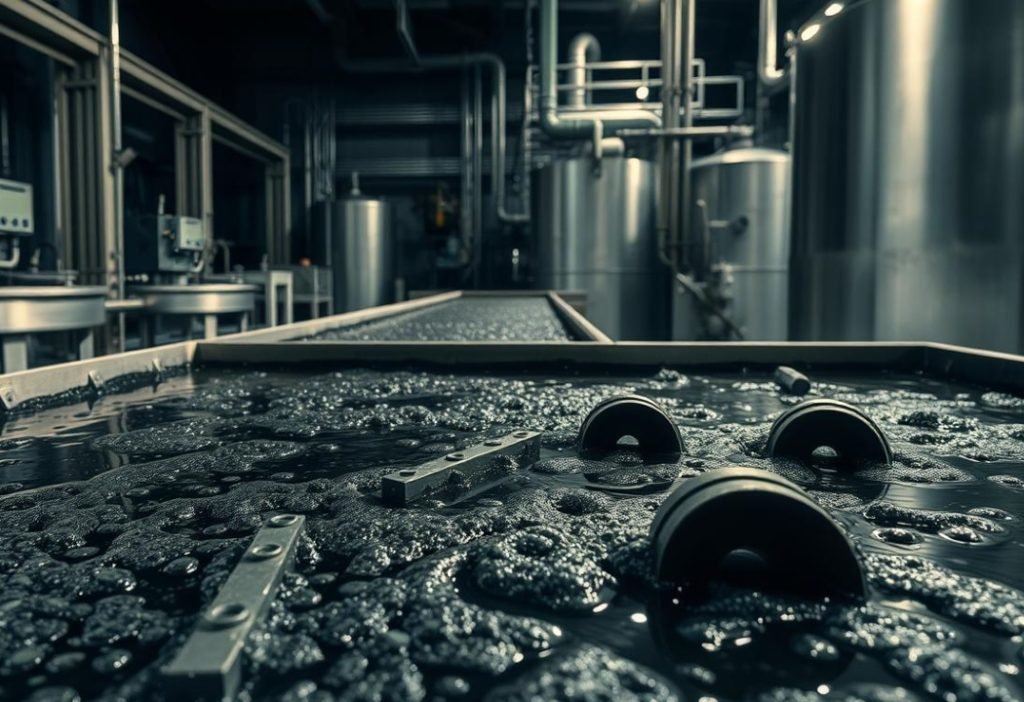Are you struggling to decide between black oxide and phosphate coating for your metal products? You’re not alone. Many manufacturers face this dilemma when trying to enhance the corrosion resistance and durability of their materials.
Both coating processes are widely used in various industries to protect metal surfaces, but they have distinct characteristics and applications. Understanding the differences between these two coating technologies is crucial for making informed decisions that meet your specific manufacturing needs.
As you explore your options, you’ll want to consider factors such as the coating process, surface conversion, and the level of protection required for your products. By examining the key differences between these two popular coating methods, you’ll be better equipped to choose the most suitable finish for your applications.
Understanding Black Oxide Coating
You may have come across black oxide coating, a process that transforms metal surfaces for improved performance. Black oxide coating is a chemical conversion coating used to enhance the properties of metal surfaces. This process involves a chemical reaction between the metal and a bath solution, resulting in the formation of a distinct layer on the surface.
What is Black Oxide Coating?
Black oxide coating is formed through a chemical reaction that produces magnetite (Fe3O4), a black crystalline compound that covers the metal surface. This reaction is a conversion process that alters the surface of the metal to achieve the desired properties.
The resulting magnetite layer is thin, typically ranging from 0.5 to 2.5 microns. Despite its thin profile, this layer offers high resistance to wear and provides a uniform black finish that reduces light reflection.

Chemical Composition and Properties
The black oxide coating consists primarily of magnetite (Fe3O4), a stable iron oxide compound that forms directly from the base metal. The properties of the black oxide layer include its thin profile, porous structure, and characteristic dark appearance.
While it’s often misconceived that black oxide alone provides significant corrosion protection, in reality, it requires post-treatment with oil or wax to achieve meaningful resistance to rust and corrosion. The porous nature of the black oxide coating allows it to absorb and retain oils and waxes, enhancing both corrosion protection and lubricity.
Additionally, black oxide coating maintains the dimensional accuracy of parts while offering good thermal stability, withstanding temperatures up to approximately 500°C without degradation.
The Black Oxide Coating Process
To understand how black oxide coating works, it’s essential to examine the process from start to finish. The black oxide coating process is a multi-step treatment that enhances the surface properties of metal components.
Surface Preparation and Cleaning
The first step in the black oxide coating process is surface preparation and cleaning. This involves removing dirt, oil, and other contaminants from the metal surface to ensure a clean and even coating. Effective cleaning is crucial for achieving a uniform black oxide finish.
Application Process
The application process involves immersing the cleaned metal parts in a black oxide solution. This chemical bath reacts with the metal to form a black oxide layer, providing a distinctive finish. The immersion time and solution composition are critical factors in determining the coating’s quality.
Post-Treatment Options
After the black oxide coating is applied, post-treatment options are used to enhance its properties. Common post-treatments include oil, wax, acrylic or polymer sealants, and dry film lubricants. These treatments improve corrosion resistance, lubricity, and overall performance. For instance, oil and wax treatments help to fill the porous nature of the black oxide coating, enhancing its protection capabilities.
Exploring Phosphate Coating
When it comes to metal surface treatment, phosphate coating stands out as a versatile option. Phosphate coating is a process that involves the application of a phosphate layer to metal surfaces, typically steel, to enhance their durability and resistance to corrosion.
What is Phosphate Coating?
Phosphate coating is a chemical conversion coating that reacts with the metal surface to form a layer of phosphate crystals. This layer provides a foundation for additional coatings, such as paint, and enhances the metal’s corrosion resistance. The phosphate coating process involves several steps, including surface preparation, application of the phosphate solution, and rinsing.
Types of Phosphate Coatings
There are three primary types of phosphate coatings: zinc phosphate, manganese phosphate, and iron phosphate. Zinc phosphate is the most common type, offering excellent corrosion resistance and paint adhesion, making it ideal for automotive body panels and general industrial applications. Manganese phosphate creates a darker, more durable coating with superior wear resistance, often used in high-stress components like gears and bearings. Iron phosphate is a lighter, thinner coating used primarily as a paint base where moderate corrosion resistance is needed.
Each type of phosphate coating has distinct properties and applications. The choice between them depends on the specific requirements of the application, including the level of corrosion protection needed, wear resistance, and whether the coating will serve as a base for paint or other finishes.
The Phosphate Coating Process
To understand the phosphate coating process, it’s essential to break down its key components and how they contribute to the final product. The phosphate coating process involves several critical stages that work together to provide a durable and corrosion-resistant coating.
Surface Preparation
Surface preparation is a crucial step in the phosphate coating process. It involves cleaning the metal surface to remove dirt, oil, or other contaminants that could interfere with the coating. Proper surface preparation ensures a strong bond between the metal and the phosphate coating, enhancing its durability and corrosion resistance.
Activation and Application
After surface preparation, the metal is activated to promote the formation of a phosphate coating. The phosphate coating is then applied through a process that involves immersion or spraying of a phosphate solution. This solution reacts with the metal surface to form a crystalline phosphate coating that provides excellent corrosion resistance and protection.
Rinsing and Sealing
Rinsing is a critical step after the phosphate coating application. It helps remove excess chemicals and unreacted metal salts, preventing surface contamination and corrosion. Multiple rinse stages, often using regular water followed by deionized water, are typically employed. After rinsing, sealing is performed to enhance the protective properties of the phosphate coating. Various sealing options, including oil, wax, chromate treatments, and organic sealants, are used depending on the intended application and desired level of protection.
Black Oxide vs Phosphate Coating: Key Differences
When considering surface treatment options, understanding the differences between black oxide and phosphate coatings is crucial. Both are used to enhance the durability and corrosion resistance of metal parts, but they have distinct characteristics.
Differences in Coating Process
The application process for black oxide and phosphate coatings differs significantly. Black oxide coating involves immersing the metal part in an alkaline solution, typically heated to a specific temperature, to form a magnetite layer. In contrast, phosphate coating requires a more complex process involving acidic solutions and activators to create a phosphate layer on the metal surface.
This difference in process complexity affects not only the application time but also the equipment and chemicals required, influencing the overall cost.
Corrosion Protection Capabilities
Phosphate coating generally offers superior corrosion protection compared to black oxide coating. The thicker phosphate layer provides a more robust barrier against corrosive elements. However, black oxide coating still provides adequate corrosion resistance for many applications, especially when used in conjunction with a sealant or lubricant.
Adhesion and Durability Comparison
Phosphate coatings are known for their excellent paint adhesion properties, making them ideal for parts that will be painted. Black oxide coating, while providing a good surface for lubricants, may not offer the same level of paint adhesion. In terms of durability, phosphate coatings tend to be more durable due to their thicker layer, but black oxide coatings are still suitable for many industrial applications.
Cost-Effectiveness Analysis
When it comes to cost-effectiveness, black oxide coating is generally less expensive than phosphate coating. The simpler chemistry and fewer process steps involved in black oxide coating contribute to its lower cost. However, the total lifecycle cost may favor phosphate coating in applications where its superior durability and corrosion protection reduce long-term maintenance and replacement costs.
For instance, zinc phosphate is the most economical type of phosphate coating, while manganese phosphate is typically the most costly. The choice between black oxide and phosphate coating should consider factors like production volume, part size, and the need for additional treatments like painting.

Environmental Considerations
Environmental concerns play a pivotal role in the selection between black oxide and phosphate coating processes. As you evaluate these options, it’s essential to consider the ecological footprint of each.
Environmental Impact of Black Oxide
Black oxide coating involves the use of chemicals that can be hazardous to the environment if not handled properly. The process requires careful management of waste and chemicals to prevent environmental contamination. You should be aware that black oxide processes can have significant environmental impacts if not managed correctly.
Environmental Impact of Phosphate Coating
Phosphate coating, while generally considered less hazardous than black oxide, still poses environmental risks. The process generates wastewater containing phosphates, which can lead to eutrophication in water bodies if not treated properly. You need to implement effective waste treatment systems, including neutralization, precipitation, and filtration, to minimize environmental impact. Modern phosphate formulations have been developed to reduce environmental effects, including low-temperature processes and phosphate-free alternatives.
Regulatory compliance for phosphate coating operations typically includes wastewater discharge permits and monitoring requirements to ensure environmental protection. By understanding these environmental considerations, you can make more informed decisions about your coating processes.
Industrial Applications
Both Black Oxide and Phosphate Coatings have diverse applications across various industries, contributing to the longevity and efficiency of metal parts. These coatings are utilized to enhance the performance and durability of components in different sectors.
Common Applications for Black Oxide Coating
Black Oxide Coating is commonly used in applications where a decorative or functional finish is required. It is often applied to steel parts and tools to provide a corrosion-resistant finish. This coating is also used in the manufacture of components that require a low-friction surface. The Black Oxide finish is particularly beneficial in industries where metal parts are exposed to harsh environments.
Common Applications for Phosphate Coating
Phosphate Coating has a wide range of industrial applications, particularly in the automotive sector, where it is used to coat engine components, frames, and car body panels. Zinc phosphate is used as a paint base in appliances, metal furniture, and architectural components due to its excellent paint adhesion properties. Manganese phosphate is critical in high-wear applications like gears, bearings, and powertrain components, providing lubricity and wear resistance. Phosphate coatings are also used in military and firearms applications, fasteners, and hardware exposed to outdoor environments, where superior corrosion protection is required.
Choosing the Right Coating for Your Needs
Selecting the appropriate coating for your project involves understanding the specific requirements of your application. Both black oxide and phosphate coatings have their unique advantages and are suited for different environments and part specifications.
Factors to Consider
When deciding between black oxide and phosphate coating, consider the dimensional tolerance of your parts, the operating environment, and the desired finish. For parts requiring minimal dimensional change and a sleek finish, black oxide may be the preferred choice. In contrast, phosphate coating is ideal for applications needing superior corrosion resistance and paint adhesion.
Decision-Making Framework
To systematically evaluate your coating needs, consider the following factors: the level of corrosion protection required, whether the parts will be painted, the operating environment’s harshness, and the need for dimensional precision. For instance, opt for black oxide when aesthetics and dimensional precision are critical, and choose phosphate coating when superior corrosion resistance and durability are paramount.
Conclusion
Ultimately, understanding the differences between black oxide and phosphate coating is crucial for selecting the right finish for your parts. Black oxide excels in applications requiring dimensional precision and aesthetic appeal, offering moderate corrosion resistance. Phosphate coating, on the other hand, provides superior corrosion resistance and wear resistance, making it ideal for harsh environments. By analyzing your application’s specific needs, you can make an informed decision that enhances product quality and performance.




